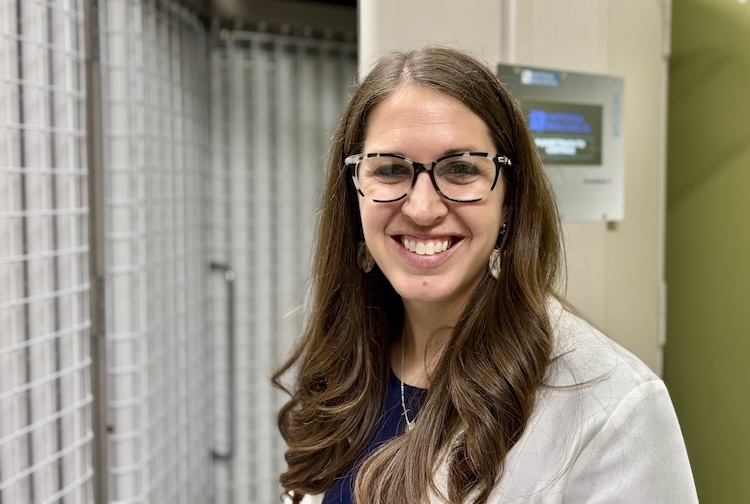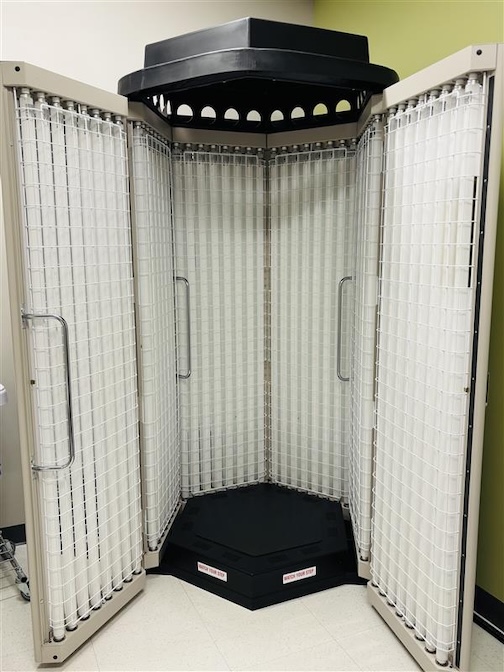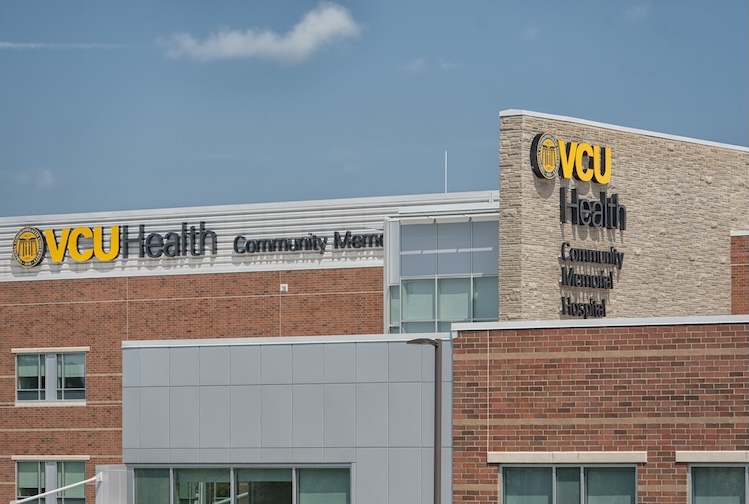What is phototherapy? VCU Health dermatologist explains skin benefits
A brighter option for chronic skin conditions, VCU Health Community Memorial Hospital expands dermatology care with new phototherapy unit.
August 22, 2025 VCU Health dermatologist Dr. Jade Kindley stands beside VCU Health Community Memorial Hospital’s new phototherapy machine, the latest in advanced treatment for individuals who suffer from chronic skin diseases like eczema and psoriasis. (Shea Wright, Enterprise Marketing and Communications)
VCU Health dermatologist Dr. Jade Kindley stands beside VCU Health Community Memorial Hospital’s new phototherapy machine, the latest in advanced treatment for individuals who suffer from chronic skin diseases like eczema and psoriasis. (Shea Wright, Enterprise Marketing and Communications)
By Shea Wright
Psoriasis and eczema are painful, chronic skin conditions effecting millions of people in the United States.
Both can cover large parts of a person's body, and the discomfort caused by these skin diseases goes far beyond relief provided by prescription-based steroid creams. Flare-ups can affect sleep, confidence and routine, requiring over-the-counter creams or short-term fixes.
Until recently, patients with chronic eczema or psoriasis living in Southside Virginia had to drive to Richmond two or three times a week for specialized care. Now, thanks to VCU Health Community Memorial Hospital (CMH), that relief is available closer to home.
Dermatologists at CMH are offering narrowband UVB phototherapy, a targeted light treatment shown to reduce inflammation and improve symptoms of chronic skin conditions.
“Phototherapy can be life-changing for people who’ve been struggling with itching and skin irritation that topical creams can’t resolve or in hard-to-reach places that makes reliance on others for assistance a burden. For patients who can’t take systemic medications, it offers a safe alternative that still provides relief,” said CMH dermatologist Jade Kindley, M.D.
VCU Health News spoke to Kindley, to learn about these common skin conditions and what the addition of phototherapy means for patients in rural communities.
Phototherapy is often used for eczema and psoriasis. What are symptoms of these skin conditions? And how common are they?
Psoriasis is a disease characterized by excessive inflammation in the body that causes raised, red or silvery-white, and scaly patches of skin. It effects between 3% to 4% of people in the U.S., yet it remains underdiagnosed among Black Americans and individuals with more melanin-rich skin tones.
Eczema, or atopic dermatitis, causes dry, itchy, irritated skin, is seen in up to 10% of adults nationwide regardless of skin type, with Black Americans diagnosed more often than other populations.
Environmental factors like weather, stress and infection can cause flare ups.
 Phototherapy, now available in South Hill offers safe, targeted relief for individuals with chronic skin diseases like eczema and psoriasis without the need for frequent travel to Richmond. (Shea Wright, Enterprise Marketing and Communications)
Phototherapy, now available in South Hill offers safe, targeted relief for individuals with chronic skin diseases like eczema and psoriasis without the need for frequent travel to Richmond. (Shea Wright, Enterprise Marketing and Communications)
What is phototherapy?
There are different kinds of phototherapy. In our office, we use narrowband UVB Phototherapy — a treatment that uses a targeted wavelength of ultraviolet (UV) light to calm inflammation and help the skin heal — without the broader risks associated with natural sunlight or tanning beds.
Studies have shown that UVB can reduce psoriasis severity by up to 79% after just 12 weeks. It may also reduce the need for steroid creams, which helps lower the risk of long-term side effects like skin thinning and bruising.
How long are typical phototherapy sessions? What are those sessions like?
Phototherapy sessions are usually quick and can be anywhere from a few seconds to a few minutes. During a full-body treatment, you can expect to stand inside of a vertical tanning unit, with 48 lamps all emitting the same wavelength of light (311-312 nanometers) for a set duration of time. If you are treating a smaller area, expect to lie down on an exam table, while the dermatologist uses a handheld device to emit UVB light over the targeted area.
We also use the Fitzpatrick skin type protocol to guide us based on skin type; it’s a way to classify the skin by its reaction to exposure to sunlight. Depending on a patient’s response to the previous treatment, we gradually increase exposure times until people eventually get to a level or dosage they can maintain. Patients can expect some redness or drying of the skin after each session.
Are there risks involved with phototherapy treatments?
Phototherapy is very safe when administered under clinical conditions. While it does use ultraviolet (UV) light, it does not have the same kind of UV exposure from the sun or tanning beds.
Phototherapy uses very specific wavelengths of UVB light that are carefully controlled to eliminate burning or skin cancer. These wavelengths are not the same as those used in tanning beds, and each treatment is measured precisely to keep exposure well below any threshold that could raise concerns about skin cancer.
When should I talk to a doctor about chronic skin conditions and treatment options?
Patients with long-term skin conditions like psoriasis, eczema, and certain lymphomas that affect large areas of the body, or those who have used topical treatments for extended periods with limited success are good candidates for phototherapy.
Phototherapy is a safe and effective treatment for both pediatric and adult patients, and it can significantly reduce the need for topical steroids which reduces the risk of more serious side effects such as thinning of the skin and bruising. We are excited to begin offering these services for our patients living in South Hill and the surrounding areas.
Check out more stories about VCU Health Community Memorial Hospital.




